Ellipse-Like Radiation Range Grading Method of Traffic Accident Influence on Mountain Highways
Abstract
1. Introduction
2. Literature Review
2.1. Propagation Mechanism of Accidents Impact
2.2. Analysis Method of Accident Influence Range
3. Methodology
3.1. Foundational Model Construction for Traffic Accident Influence Degree of Mountain Highway
3.2. Influence Analysis of Mountain Highway Accident Source Point on the Surrounding Road Network
3.2.1. Influence Analysis of Accident-Occurred Road Based on Gravity Field Theory
3.2.2. Influence Analysis of Accident-Intersecting Road Considering Cascading Failure
3.3. Ellipse-Like Radiation Range Model Construction of Accidents Impact of Mountain Highway
3.3.1. Accident-Occurred Road Model
- (1)
- According to Equation (19), the maximum influence distance is when the influence degree of the accident source point on the accident road is different levels (u = 1, 2, …N).
- (2)
- represents the degree of influence of traffic accidents on the maximum influence range of mountain highways, which is related to the proportion of lanes occupied by the accident, the type of accidents, and the type of accident vehicles, and it can be determined by trial calculation of actual accident data. The adjustment parameter can take the values of 1, 0.3, 0.05 [31], and .
- (3)
- The proportion of the diffusion traffic volume at the accident point is , and its value range is (0, 1), which is determined by the nature of the accident. The calibration of the proportional constant is related to the proportion of lanes occupied by accidents and the type of accidents, .
3.3.2. Accident-Intersecting Road Model
3.3.3. Grading Discussion of Ellipse-Like Radiation Range
4. Case Study
4.1. Traffic Accident Data
4.2. Ellipse-like Radiation Range Calculation of Accident Impact of Mountain Highway
4.2.1. Accident Occurred Road Range Calculation
4.2.2. Accident-Intersecting Road Range Calculation
4.2.3. Ellipse-Like Radiation Grading Range Confirmation
4.3. Model Validation
4.3.1. Simulation Experiment
- (1)
- Fundamental parameters: The two intersecting roads are both composed of four two-way lanes, with a vehicle running speed of 50 km/h, a minimum headway spacing of 2 m, an average parking distance of 1.5 m, a maximum deceleration of forced lane change of −4 m/s2, and the waiting time for lane change is 60 s. A total of 390 detectors were set up to detect the real-time speed and other data of roads near the accident point, including 120 at the south entrance, 150 at the west entrance, and 120 at the north entrance, with a detector interval of 10 m. According to the actual situation of road operation, the turning ratios of each entrance road at the intersection were as follows: the north and south entrance road were 0.2 (straight), 0.4 (left), 0.4 (right), and the west entrance road was 0.8 (straight), 0.1 (left), 0.1 (right).
- (2)
- Accident parameters: The accident occurred on the east exit road 136 m away from the intersection at 300 s, with an accident-occupied lanes proportion of 0.5 (the accident occupied the outermost lane), an accident duration of 1 h, and an accident length of 20 m. Therefore, the length of the closed lane (the length of the accident area) was set to 20 m; the deceleration zone was set to 0–50 m west of the accident location, and the lane speed near the accident area was 15 km/h; the two-lane speed at 50 m to 70 m west of the accident location was set to 20 km/h; the same-direction lane of the accident (length 20 m) and west 20 m, east 20 m (a total of 60 m) were all deceleration zones, where the speed was set to 6 km/h. After the accident treatment was completed, the deceleration zone was removed to achieve the purpose of evacuating the accident-queuing traffic. The specific schematic diagram is shown in Figure 6.
4.3.2. Model and Simulation Results Comparison
4.4. Model Portability
5. Discussion
6. Conclusions
Author Contributions
Funding
Institutional Review Board Statement
Informed Consent Statement
Data Availability Statement
Conflicts of Interest
References
- Yu, B.; Chen, Y.R.; Bao, S.; Xu, D. Quantifying Drivers’ Visual Perception to Analyze Accident-prone Locations on Two-lane Mountain Highways. Accid. Anal. Prev. 2018, 119, 122–130. [Google Scholar] [CrossRef]
- Wang, J.J.; Cao, X.D. System Analysis of Potential Accidents on Mountain Road Based on Rough Set and Quantitative Theory. KSCE J. Civ. Eng. 2021, 25, 1031–1042. [Google Scholar] [CrossRef]
- Xu, J.; Lin, W.; Wang, X.; Shao, Y.M. Acceleration and Deceleration Calibration of Operating Speed Prediction Models for Two-lane Mountain Highways. J. Transp. Eng. Part A Syst. 2017, 143, 04017024. [Google Scholar] [CrossRef]
- Zhang, H.; Zhang, M.; Zhang, C.; Hou, L. Formulating a GIS-based Geometric Design Quality Assessment Model for Mountain Highways. Accid. Anal. Prev. 2021, 157, 106172. [Google Scholar] [CrossRef] [PubMed]
- Wang, Z.L.; Qi, X.; Jiang, H. Estimating the Spatiotemporal Impact of Traffic Incidents: An Integer Programming Approach Consistent with the Propogation of Shockwaves. Transp. Res. Part B Methodol. 2018, 111, 356–369. [Google Scholar] [CrossRef]
- Yuan, Z.; Huang, D.; Tong, W.; Liu, Z. Characteristic Analysis and Prediction of Traffic Accidents in the Multiethnic Plateau Mountain Area. J. Transp. Eng. Part A Syst. 2020, 146, 04020068. [Google Scholar] [CrossRef]
- Lu, C.; Elefteriadou, L. An Investigation of Freeway Capacity Before and During Incidents. Transp. Lett. Int. J. Transp. Res. 2013, 5, 144–153. [Google Scholar] [CrossRef]
- Almotahari, A.; Yazici, M.A.; Mudigonda, S.; Kamga, C. Analysis of Incident-induced Capacity Reductions for Improved Delay Estimation. J. Transp. Eng. Part A Syst. 2019, 145, 04018083. [Google Scholar] [CrossRef]
- Hojati, A.T.; Ferreira, L.; Washington, S.; Charles, P. Hazard Based Models for Freeway Traffic Incident Duration. Accid. Anal. Prev. 2013, 52, 171–181. [Google Scholar] [CrossRef] [PubMed]
- Hojati, A.T.; Ferreira, L.; Washington, S.; Charles, P.; Shobeirinejad, A. Modelling Total Duration of Traffic Incidents Including Incident Detection and Recovery Time. Accid. Anal. Prev. 2014, 71, 296–305. [Google Scholar] [CrossRef]
- Lan, C.L.; Venkatanarayana, R.; Fontaine, M.D. Development of a Methodology for Determining Statewide Recurring and Nonrecurring Freeway Congestion: Virginia Case Study. Transp. Res. Rec. 2019, 2673, 566–578. [Google Scholar] [CrossRef]
- Wang, J.H.; Xie, W.J.; Liu, B.Y.; Fang, S.; Raglandbc, D.R. Identification of Freeway Secondary Accidents with Traffic Shock Wave Detected by Loop Detectors. Saf. Sci. 2016, 87, 195–201. [Google Scholar] [CrossRef]
- Shannon, D.; Murphy, F.; Mullins, M.; Eggert, J. Applying Crash Data to Injury Claims-an Investigation of Determinant Factors in Severe Motor Vehicle Accidents. Accid. Anal. Prev. 2018, 113, 244–256. [Google Scholar] [CrossRef] [PubMed]
- Tainter, F.; Fitzpatrick, C.; Gazillo, J.; Riessman, R.; Knodler, M., Jr. Using a Novel Data Linkage Approach to Investigate Potential Reductions in Motor Vehicle Crash Severity—An Evaluation of Strategic Highway Safety Plan Emphasis Areas. J. Safety Res. 2020, 74, 9–15. [Google Scholar] [CrossRef]
- Liu, L.; Zhu, L.; Yang, D. Modeling and Simulation of the Car-truck Heterogeneous Traffic Flow Based on a Nonlinear Car-Following Model. App. Math. Comput. 2016, 273, 706–717. [Google Scholar] [CrossRef]
- Khatak, A.; Wang, X.; Zhang, H. Incident Management Integration Tool: Dynamically Predicting Incident Durations, Secondary Incident Occurrence and Incident Delays. IET Intell. Transp. Sy. 2012, 6, 204–214. [Google Scholar] [CrossRef]
- Chung, Y.; Recker, W.W. Frailty Models for the Estimation of Spatiotemporally Maximum Congested Impact Information on Freeway Accidents. IEEE Trans. Intell. Transp. Syst. 2015, 16, 2104–2112. [Google Scholar] [CrossRef]
- Chung, Y. Identification of Critical Factors for Non-recurrent Congestion Induced by Urban Freeway Crashes and Its Mitigating Strategies. Sustainability 2017, 9, 2331. [Google Scholar] [CrossRef]
- Moskowitz, K.; Newman, L. Notes on Freeway Capacity, 3rd ed.; California Division of Highways: Sacramento, CA, USA, 1962.
- Lawson, T.W.; Lovell, D.J.; Daganzo, C.F. Using Input-output Diagram to Determine Spatial and Temporal Extents of a Queue Upstream of a Bottleneck. Transp. Res. Rec. 1997, 1572, 140–147. [Google Scholar] [CrossRef]
- Saeedmanesh, M.; Geroliminis, N. Dynamic Clustering and Propagation of Congestion in Heterogeneously Congested Urban Traffic Network. Transp. Res. Part B Methodol. 2017, 105, 193–211. [Google Scholar] [CrossRef]
- Barth, M.; Boriboonsomsin, K. Energy and Emissions Impacts of a Freeway-based Dynamic Eco-driving System. Transp. Res. Part D Transp. Environ. 2009, 14, 400–410. [Google Scholar] [CrossRef]
- Kong, D.; Sen, L.; Li, J.; Xu, Y. Modeling Cars and Trucks in the Heterogeneous Traffic Based on Car-truck Combination Effect Using Cellular Automata. Phys. A 2021, 562, 125–329. [Google Scholar] [CrossRef]
- Chen, Q.J.; Song, X.; Yamada, H.; Shibasaki, R. Learning Deep Representation from Big and Heterogeneous Data for Traffic Accident Inference. In Proceedings of the 2016 30th AAAI Conference on Artificial Intelligence (AAAI-16), Phoenix, AZ, USA, 12–17 February 2016; pp. 338–344. [Google Scholar]
- Yang, H.; Wang, Z.; Xie, K.; Dai, D. Use of Ubiquitous Probe Vehicle Data for Identifying Secondary Crashes. Transp. Res. Part C Emerg. Technol. 2017, 82, 138–160. [Google Scholar] [CrossRef]
- Chen, Z.; Liu, X.C.; Zhang, G. Non-recurrent Congestion Analysis Using Data-driven Spatiotemporal Approach for Information Construction. Transp. Res. Part C Emerg. Technol. 2016, 71, 19–31. [Google Scholar] [CrossRef]
- Najjar, A.; Kaneko, S.; Miyanaga, Y. Combining Satellite Imagery and Open Data to Map Road Safety. In Proceedings of the 2017 31th AAAI Conference on Artificial Intelligence (AAAI-17), San Francisco, CA, USA, 4–9 February 2017; pp. 4524–4530. [Google Scholar]
- Li, P.; Abdel-Aty, M.; Yuan, J. Real-time Crash Risk Prediction on Arterials Based on LSTM-CNN. Accid. Anal. Prev. 2020, 135, 105371. [Google Scholar] [CrossRef]
- MOHURD (Ministry of Housing and Urban-Rural Development of the People’s Republic of China). Technical Guidelibnes for Traffic Impact Analysis of Construction Project(R); MOHURD: Beijing, China, 2010.
- Fan, X. Application of Spherical Extrapolation Method to TIA. Comput. Comm. 2007, 25, 137–140. [Google Scholar]
- Wang, L.; Liu, X.M.; Ren, F.T. Cloud Model of Deciding Study Area in Traffic Impact Analysis. China J. Highw. Transp. 2001, 14, 100–105. [Google Scholar]
- Abdel-Wahab, M.; Essa, K.M.; Embaby, M.; Elsaid, S.M. Some Characteristic Parameters of Gaussian Plume Model. Mausam 2012, 63, 123–128. [Google Scholar] [CrossRef]
- Ma, G.; Zheng, C.; Wan, X. Determination of the Scope of Traffic Incident. Adv. Mech. Eng. 2017, 9. [Google Scholar] [CrossRef]
- Yang, H.; Wang, Z.; Xie, K.; Ozbay, K.; Imprialou, M. Methodological Evolution and Frontiers of Identifying, Modeling and Preventing Secondary Crashes on Highways. Accid. Anal. Prev. 2018, 117, 40–54. [Google Scholar] [CrossRef]
- Fallah-Shorshani, M.; Shekarrizfard, M.; Hatzopoulou, M. Evaluation of Regional and Local Atmospheric Dispersion Models for the Analysis of Traffic-related Air Pollution in Urban Areas. Atmos. Environ. 2017, 167, 270–282. [Google Scholar] [CrossRef]
- SBQTS (State Bureau of Quality and Technical Supervision); SBEPA (State Environmental Protection Administration). Technical Methods for Making Local Emission Standards of Air Pollutants. SBQTS: Beijing, China; SBEPA: Beijing, China, 1991. [Google Scholar]
- MTPRC (Ministry of Transport of the People’s Republic of China). Technical Standard of Highway Engineering; MOHURD: Beijing, China, 2014.
- Huang, F.; Liu, P.; Yu, H.; Wang, W. Identifying if VISSIM simulation model and SSAM provide reasonable estimates for field measured traffic conflicts at signalized intersections. Accid. Anal. Prev. 2013, 50, 1014–1024. [Google Scholar] [CrossRef] [PubMed]
- Zheng, Z.; Qi, X.; Wang, Z.; Ran, B. Incorporating Multiple Congestion Levels Into Spatiotemporal Analysis for the Impact of a Traffic Incident. Accid. Anal. Prev. 2021, 159, 106255. [Google Scholar] [CrossRef] [PubMed]
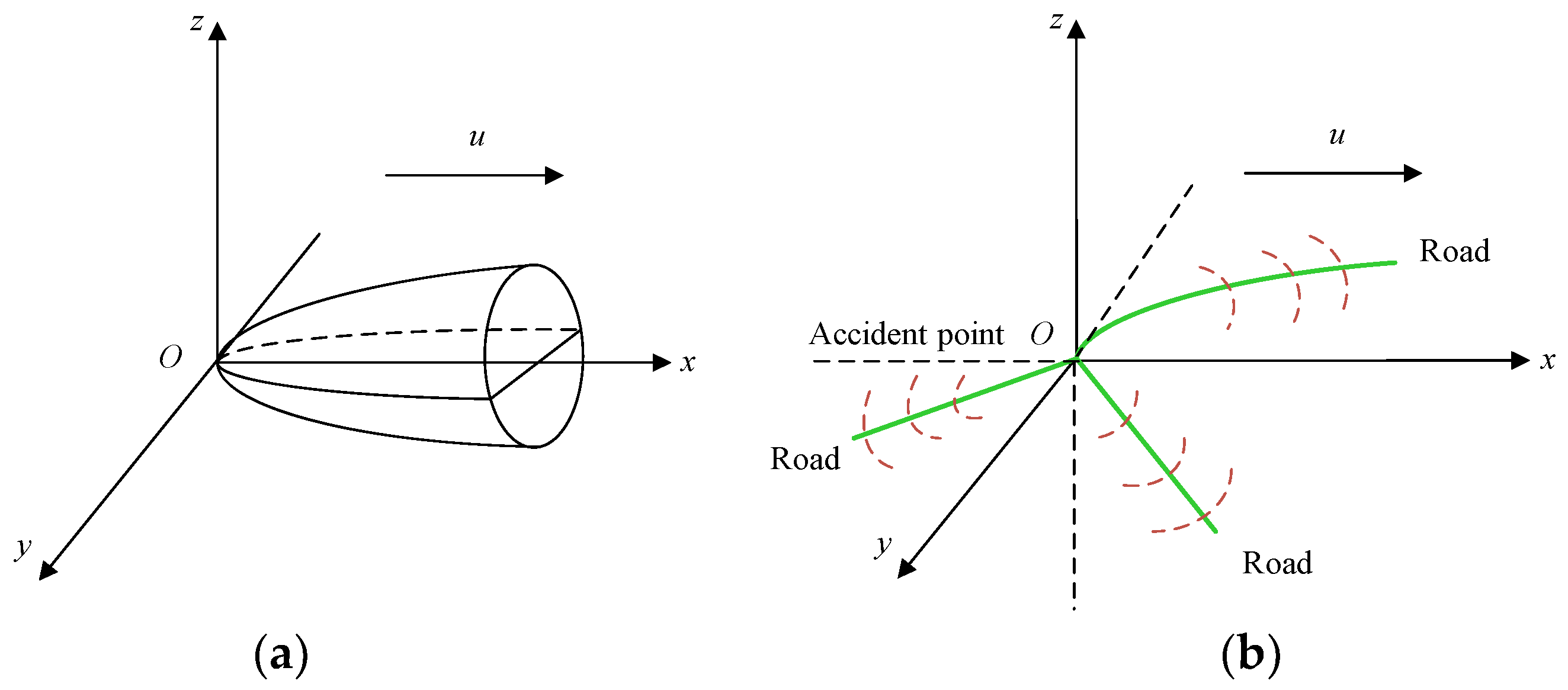
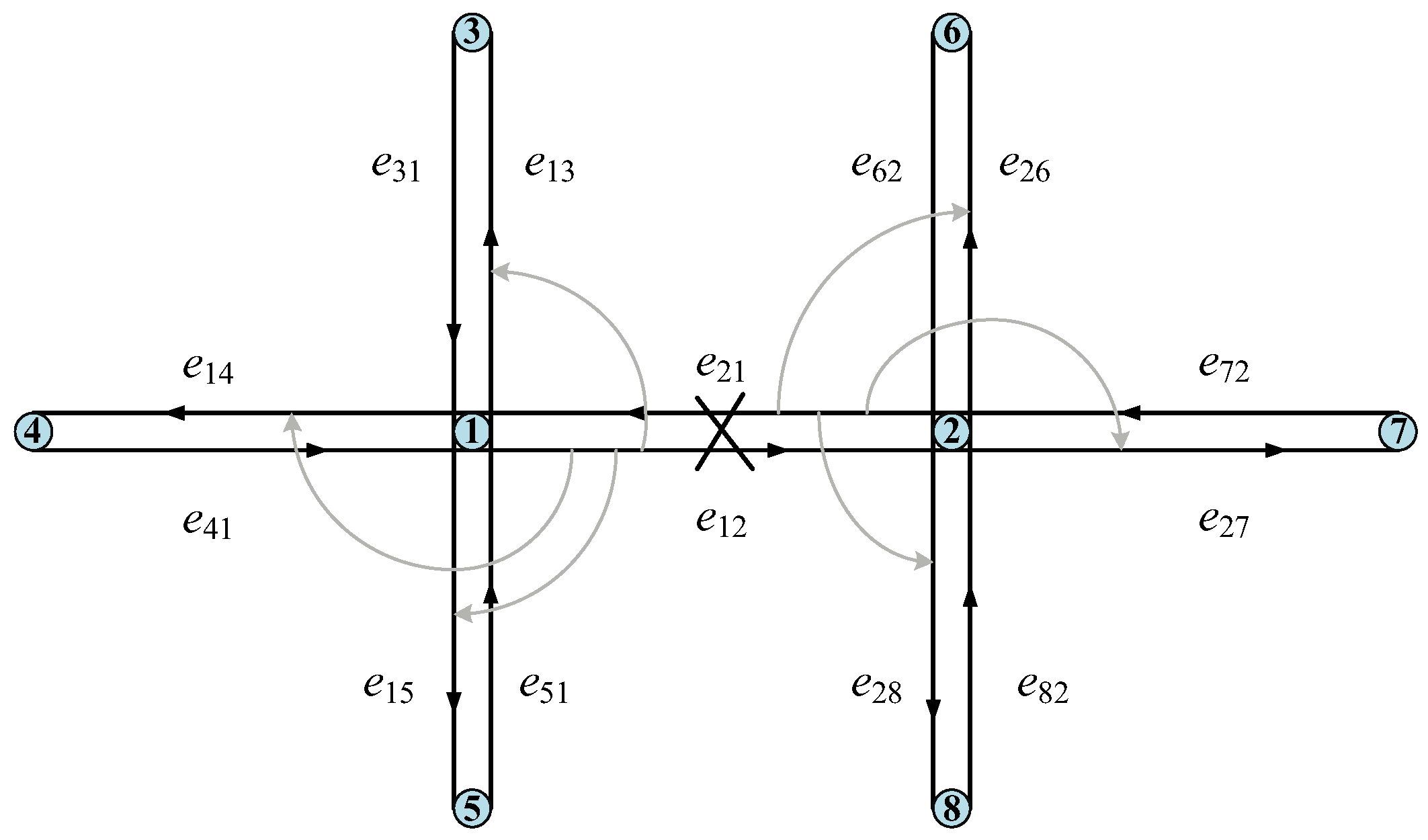

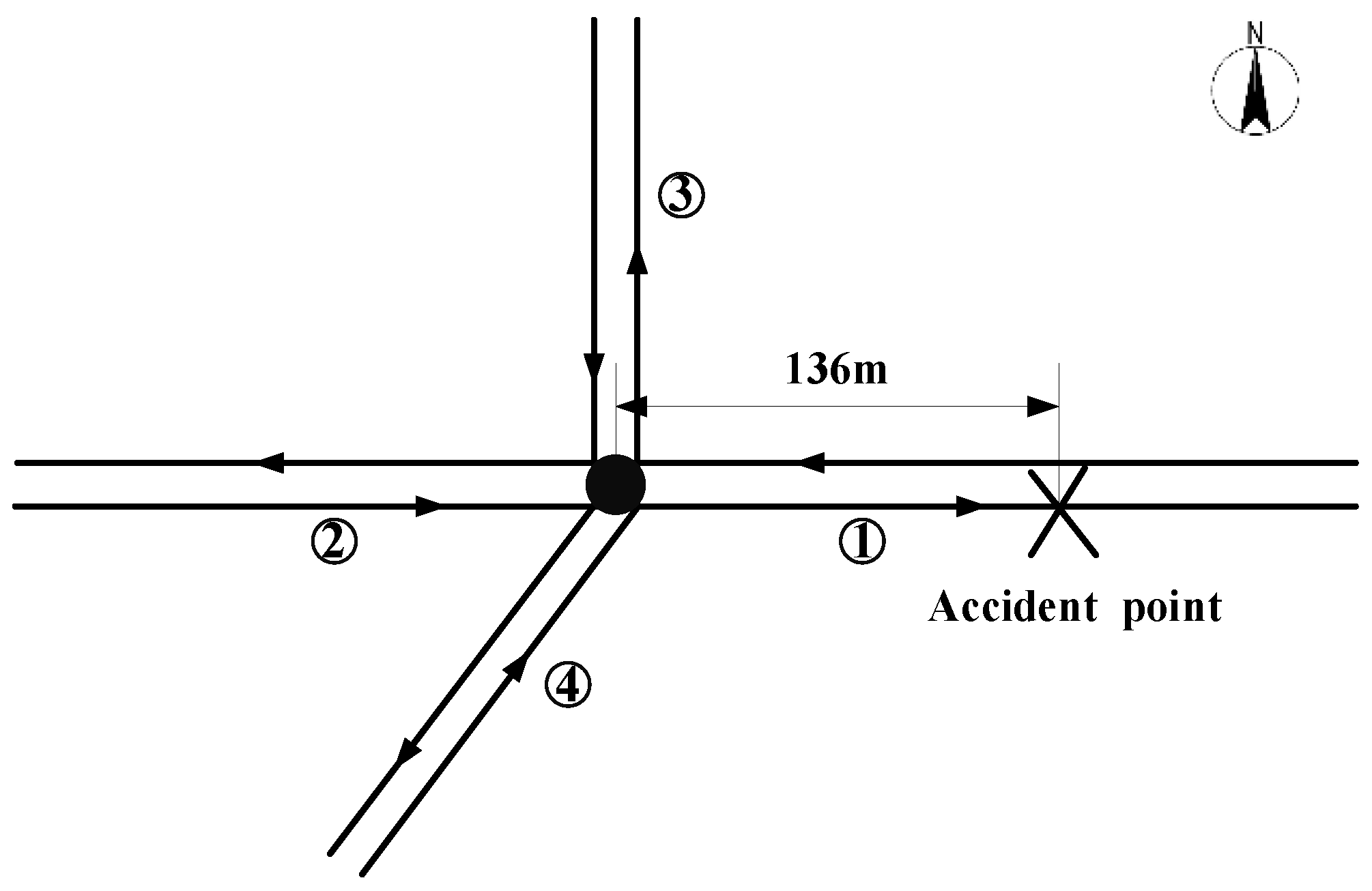
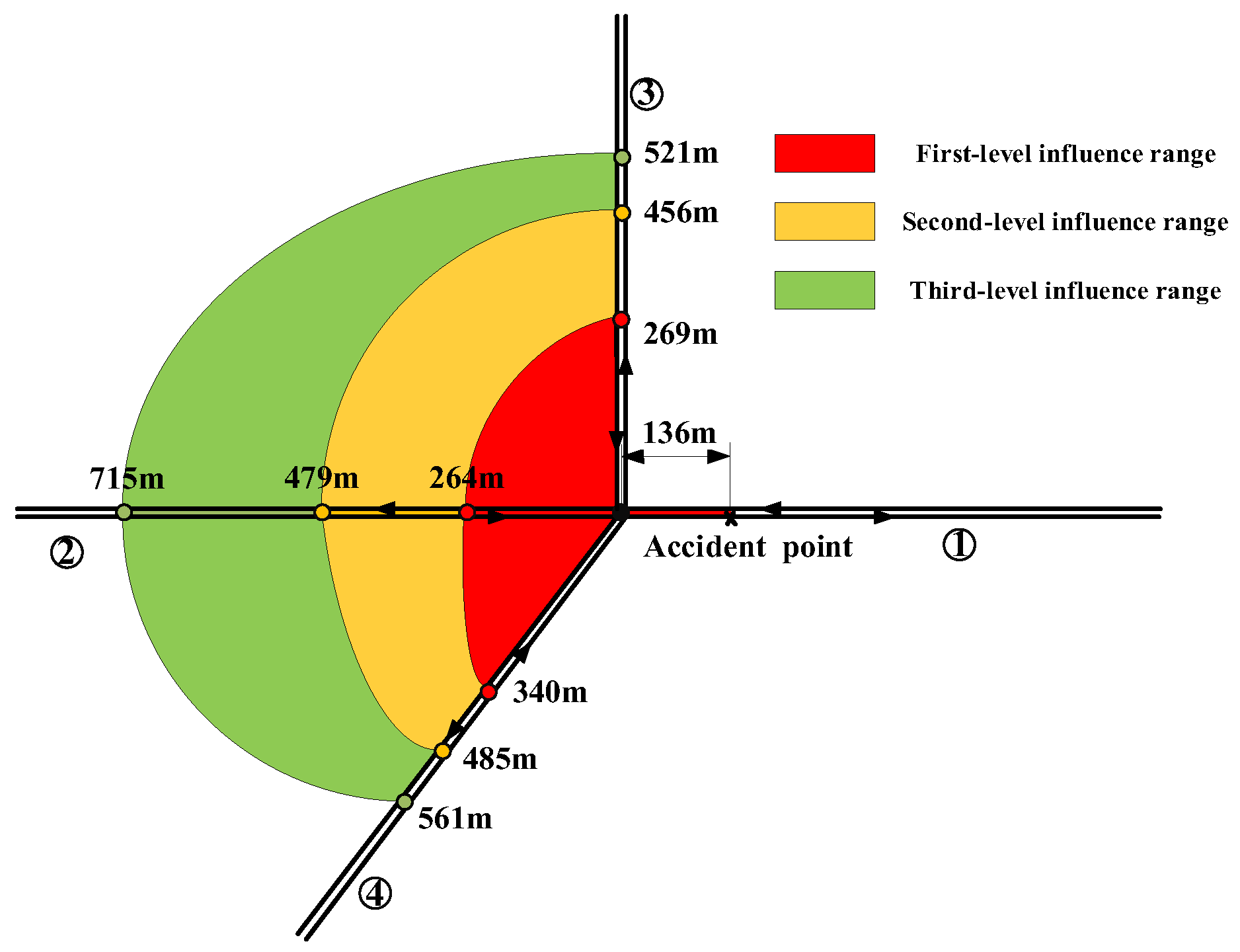
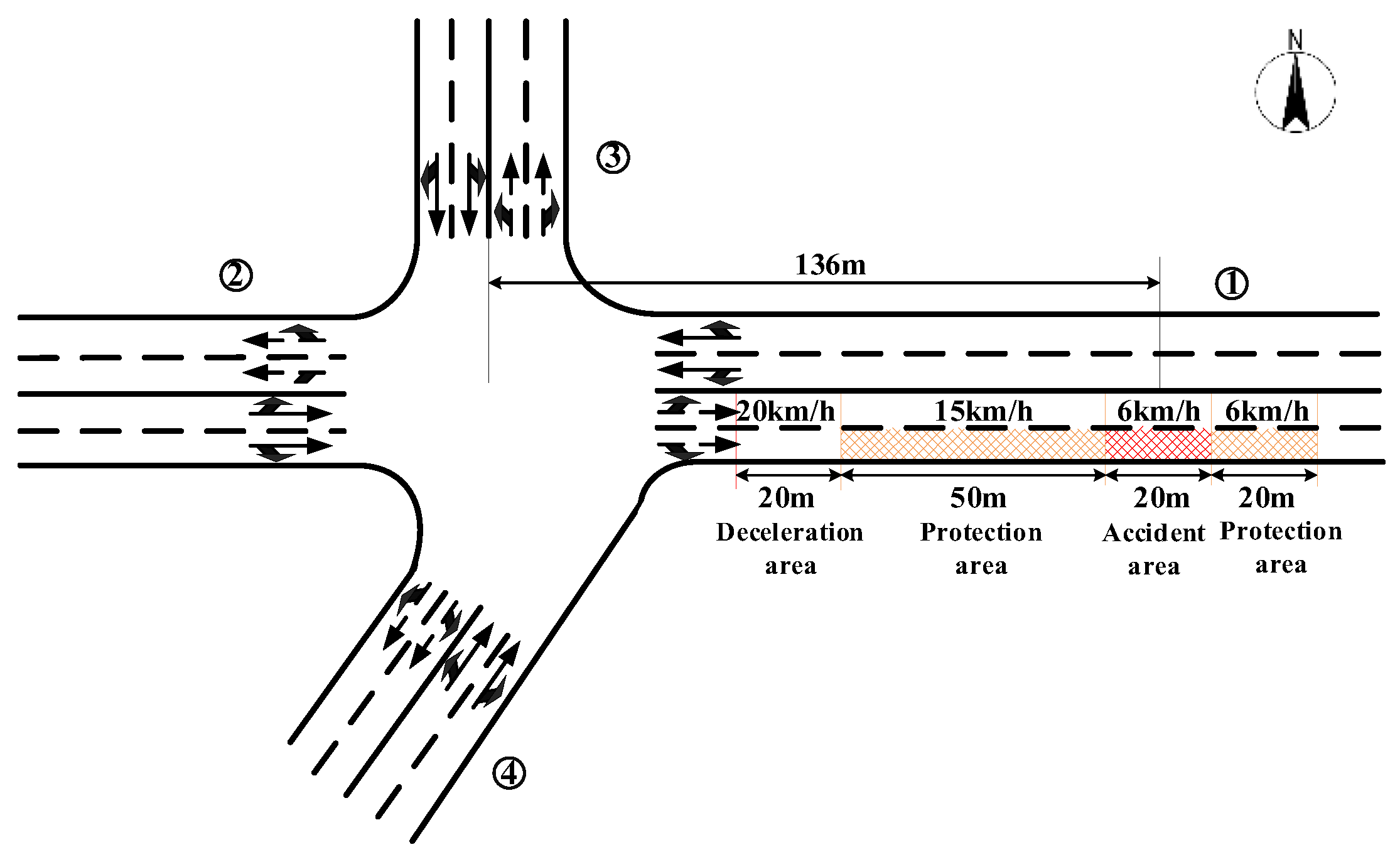
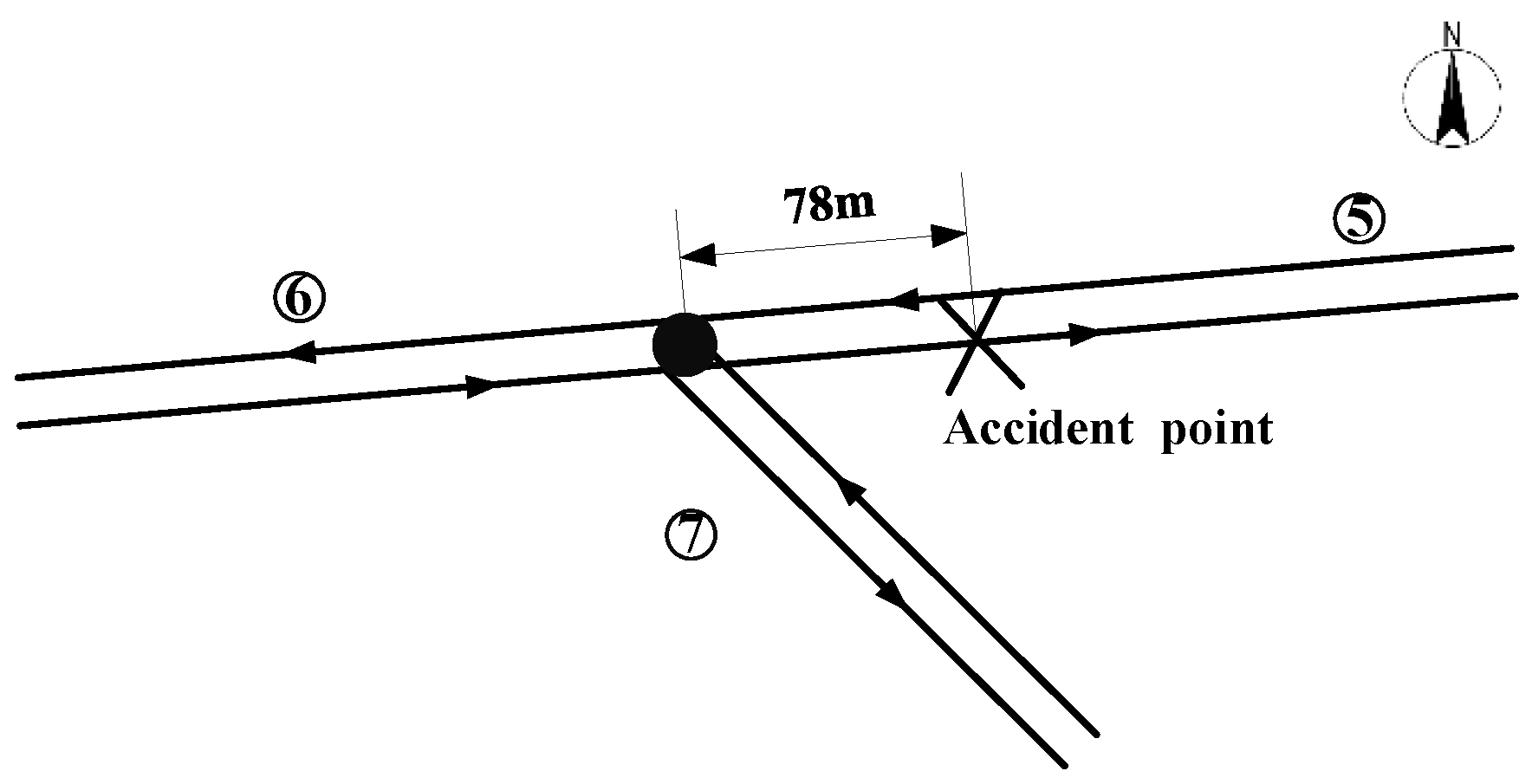


| Main Indicators | Indicator Values | Unit | Main Indicators | Indicator Values | Unit |
|---|---|---|---|---|---|
| Upstream traffic | 680 | pcu/h/ln | Free-flow speed | 60 | km/h |
| Traffic composition | 15 | % | Road occupation ratio | 50 | % |
| Average running speed | 50 | km/h | Average traffic density | 16.89 | pcu/km/ln |
| Road saturation | 62 | % | Critical velocity | 35 | km/h |
| Traffic capacity | 900 | pcu/h/ln | Jamming density | 80 | pcu/km/ln |
| Accident Stage | Before the Accident | After the Accident | Accident Disposal Stage | Accident Clearance Phase |
|---|---|---|---|---|
| traffic flow (pcu/h/ln) | 680 | 550 | 360 | 370 |
| Model Prediction Project | Road Section | ||||
|---|---|---|---|---|---|
| ② | ③ | ④ | |||
| Models’ prediction results | Model 1: Queuing theory model | Maximum queuing length (first-level influence range) | 258 | / | / |
| Model 2: Radiation range model of accident influence | first-level influence range | 264 | 269 | 340 | |
| second-level influence range | 479 | 456 | 485 | ||
| third-level influence range | 715 | 521 | 561 | ||
| Simulation Method | first-level influence range | 270 (2660 s) | 280 (3080 s) | 330 (2780 s) | |
| second-level influence range | 470 (3020 s) | 450 (3440 s) | 480 (3020 s) | ||
| third-level influence range | 720 (3600 s) | 510 (3600 s) | 570 (3600 s) | ||
| Road Section Number | Model Relative Error (Reference: Model 1) | |
|---|---|---|
| Model 2 and Model 1 | Simulation Method and Model 1 | |
| Road section ② | 2.33% | 4.65% |
| Road Section Number | Relative Error between Model 2 and Simulation Method (Reference: Simulation Method) | |
|---|---|---|
| Road section ② | first-level influence range | 2.22% |
| second-level influence range | 1.91% | |
| third-level influence range | 0.69% | |
| Road section ③ | first-level influence range | 3.92% |
| second-level influence range | 1.33% | |
| third-level influence range | 2.15% | |
| Road section ④ | first-level influence range | 3.03% |
| second-level influence range | 1.04% | |
| third-level influence range | 1.58% | |
| Model Prediction Project | Road Section | |||
|---|---|---|---|---|
| ② | ③ | |||
| Models’ prediction results | Model 1: queuing theory model | Maximum queuing length (first-level influence range) | 211 | / |
| Model 2: radiation range model of accident influence | first-level influence range | 209 | 269 | |
| second-level influence range | 393 | 456 | ||
| third-level influence range | 595 | 521 | ||
| Simulation Method | first-level influence range | 220 (1760 s) | 230 (1980 s) | |
| second-level influence range | 400 (2240 s) | 370 (3440 s) | ||
| third-level influence range | 610 (2890 s) | 490 (3600 s) | ||
| Road Section Number | Model Relative Error (Reference: Model 1) | |
|---|---|---|
| Model 2 and Model 1 | Simulation Method and Model 1 | |
| Road section ⑥ | 0.95% | 4.26% |
| Road Section Number | Relative Error between Model 2 and Simulation Method (Reference: Simulation Method) | |
|---|---|---|
| Road section ⑥ | first-level influence range | 5.00% |
| second-level influence range | 1.75% | |
| third-level influence range | 2.46% | |
| Road section ⑦ | first-level influence range | 3.72% |
| second-level influence range | 1.33% | |
| third-level influence range | 2.15% | |
Publisher’s Note: MDPI stays neutral with regard to jurisdictional claims in published maps and institutional affiliations. |
© 2022 by the authors. Licensee MDPI, Basel, Switzerland. This article is an open access article distributed under the terms and conditions of the Creative Commons Attribution (CC BY) license (https://creativecommons.org/licenses/by/4.0/).
Share and Cite
Wang, J.; Wang, S.; Long, X.; Li, D.; Ma, C.; Li, P. Ellipse-Like Radiation Range Grading Method of Traffic Accident Influence on Mountain Highways. Sustainability 2022, 14, 13727. https://doi.org/10.3390/su142113727
Wang J, Wang S, Long X, Li D, Ma C, Li P. Ellipse-Like Radiation Range Grading Method of Traffic Accident Influence on Mountain Highways. Sustainability. 2022; 14(21):13727. https://doi.org/10.3390/su142113727
Chicago/Turabian StyleWang, Jianjun, Sai Wang, Xueqin Long, Dongyi Li, Chicheng Ma, and Peng Li. 2022. "Ellipse-Like Radiation Range Grading Method of Traffic Accident Influence on Mountain Highways" Sustainability 14, no. 21: 13727. https://doi.org/10.3390/su142113727
APA StyleWang, J., Wang, S., Long, X., Li, D., Ma, C., & Li, P. (2022). Ellipse-Like Radiation Range Grading Method of Traffic Accident Influence on Mountain Highways. Sustainability, 14(21), 13727. https://doi.org/10.3390/su142113727










